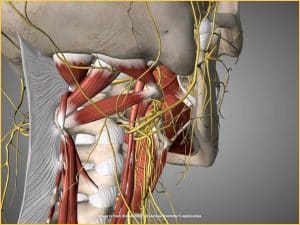A Vagus Nerve Review | Childhood Obesity News

In the past months, the vagus nerve has been showing up quite a lot in the media. Before moving on to consider more recent theories and claims connected with this anatomical feature, it will be useful to recollect some past mentions of it in Childhood Obesity News and other sources. The vagus nerve connects the brain to the heart, lungs, digestive tract, and several other entities.
This quotation from technology writer Aaron Mamiit gives a basic explanation of what the nerve does:
Functions of the vagus nerve involve the enabling of several mechanisms in the human metabolic and gastrointestinal systems, including stomach expansion, stomach contraction, gastric acid release, stomach content release into the small intestine, digestive pancreatic enzyme secretion and the sensations of both hunger and fullness.
Some have gone so far as to call the human gut the “second brain.” It is full of the same neurotransmitters as the brain, and the vagus nerve hooks the brain and gut together as definitively as a pair of conjoined twins. Even if either party objected to such a close and codependent association, they have no choice in the matter.
When the microbiome is out of balance, it can act locally, to cause inflammatory bowel disease complete with pain, vomiting, and diarrhea. Thanks to the vagus nerve, it apparently also has the power to reach all the way up into the brain and cause reactions there, that are the loftier equivalents of pain, vomiting, and diarrhea. It has even been suggested that the “addictive personality” originates not in the mind, but in the intestines.
What’s down there anyway?
The microbiome is made up of several different kinds of organisms. Scientific efforts to sort out the bad from the good became laughable when researchers realized that disease-causing strains can, on occasion, be useful and helpful. Conversely, the most seemingly benign sorts can, under the wrong conditions, damage us.
Our tenants, the gut bugs, can manipulate behavior and mood by altering the neural signals in the vagus nerve. Their tricks include the ability to produce toxins that make us feel bad, and release chemical rewards to make us feel good, and change taste receptors (making certain foods “taste better”). Oh, and release hunger-inducing hormones.
The small intestine is also inhabited by enteroendocrine cells, or EECs, which are important in ways not yet fully comprehended, but we do know they influence obesity. They differentiate into about 15 kinds of cells, and each one only lives from three to five days, so they are constantly being replaced. (Their dead bodies feed the gut bugs.)
The sub-category called L cells makes glucagon-like peptide-1, more familiarly known as GLP-1, which has received a lot of publicity lately. It regulates appetite and consumption by accessing the vagus nerve to influence the brainstem and hypothalamus. Other L cells are responsible for GLP-2, active in the inflammation associated with obesity. The EECs live cheek-by-jowl with the microbiota with whom they interact in ways that are, as yet, not fully comprehended.
Your responses and feedback are welcome!
Source: “Appetite Pacemaker: Here’s How this Weight Loss Implant Works,” TechTimes.com, 01/15/15
Image by Beth Scupham/ATTRIBUTION 2.0 GENERIC








